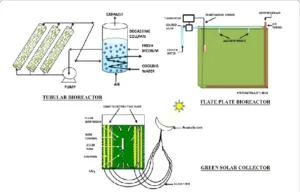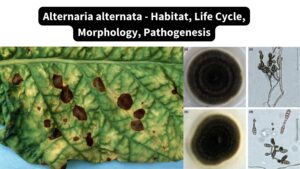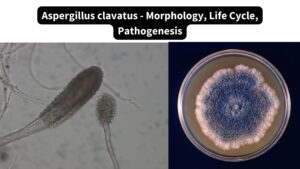| Kingdom: | Fungi |
| Division: | Ascomycota |
| Class: | Eurotiomycetes |
| Order: | Eurotiales |
| Family: | Trichocomaceae |
| Genus: | Aspergillus |
| Species: | A. fumigatus |
Aspergillus fumigatus
- Aspergillus fumigatus is a fungus species belonging to the genus Aspergillus, and it is one of the most prevalent Aspergillus species to cause disease in immunocompromised individuals.
- Aspergillus fumigatus, a ubiquitous saprotroph, is commonly found in soil and decaying organic matter, such as compost piles, where it plays a crucial role in carbon and nitrogen recycling.
- Colonies of the fungus generate conidiophores, which contain thousands of minute grey-green conidia (2–3 m) that readily disperse into the atmosphere.
- A. fumigatus was believed to reproduce asexually for many years because neither mating nor meiosis had ever been observed. In 2008, 145 years after Fresenius’s initial description, it was discovered that A. fumigatus has a fully functional sexual reproduction cycle.
- Although A. fumigatus is found in regions with vastly different climates and environments, it exhibits minimal genetic diversity and a lack of genetic population differentiation on a global scale. Thus, sexual reproduction is maintained despite the fact that little genetic variation is produced.
- The fungus is capable of growth at 37 °C or 99 °F (normal human body temperature) and can grow at temperatures up to 50 °C or 122 °F, with conidia surviving at 70 °C or 158 °F, which are conditions it frequently encounters in self-heating compost heaps.
- Its spores are ubiquitous in the atmosphere, and everyone inhales an estimated several hundred spores per day; in healthy individuals, the immune system eliminates them swiftly.
- In immunocompromised individuals, such as organ transplant recipients and those with AIDS or leukemia, the fungus is more likely to become pathogenic, invading the host’s diminished defenses and causing a spectrum of diseases collectively known as aspergillosis.
- Due to the recent increase in the use of immunosuppressants to treat human diseases, it is estimated that A. fumigatus is responsible for between 25 and 90 percent of over 600,000 fatalities annually. This opportunistic behavior has been attributed to multiple virulence factors.
- Upon screening the fermentation fluid of A. fumigatus, several indolic alkaloids with antimitotic properties were identified. The compounds of interest belong to the class of tryprostatins, with spirotryprostatin B attracting particular attention as a potential anticancer agent.
- On certain building materials, Aspergillus fumigatus can produce genotoxic and cytotoxic mycotoxins, such as gliotoxin.
General Characteristics of Aspergillus spp
Aspergillus spp. is a group of fungi that belong to the Ascomycota phylum. There are over 200 species of Aspergillus, and they are ubiquitous in nature, being found in soil, decaying organic matter, and on food items. Here are some general characteristics of Aspergillus spp:
- Morphology: Aspergillus spp. are filamentous fungi that produce long, branching hyphae. The hyphae form a mycelium, which can be either white or colored, depending on the species.
- Reproduction: Aspergillus spp. reproduce asexually by producing spores, which are dispersed by air currents. The spores are typically small, round, and have a characteristic rough surface.
- Habitat: Aspergillus spp. are found in a variety of habitats, including soil, decaying organic matter, and on food items such as grains, nuts, and fruits. They can also be found in indoor environments, such as buildings and homes.
- Pathogenicity: Some species of Aspergillus are pathogenic and can cause disease in humans and animals. For example, Aspergillus fumigatus can cause aspergillosis, a respiratory disease that can be life-threatening in immunocompromised individuals.
- Industrial uses: Aspergillus spp. have a variety of industrial uses, including the production of enzymes and the fermentation of food and beverages. For example, Aspergillus oryzae is used in the production of soy sauce and sake.
- Genetic diversity: Aspergillus spp. exhibit a high degree of genetic diversity and can produce a wide range of secondary metabolites, some of which are toxic to humans and animals. Aspergillus flavus, for example, produces aflatoxin, a potent carcinogen that can contaminate food crops such as peanuts and corn.
Epidemiology
- A few hundred conidia are inhaled by humans on a daily basis, on average.
- The prevalence of species has shifted over the past decade. A. fumigatus was once responsible for 90% of all infections. Recent research indicates that A. fumigatus species complex is responsible for approximately 60% of infections, followed by A. flavus, Aspergillus niger, and A. terreus, in that order.
- Usually, invasive pulmonary aspergillosis occurs in patients with underlying conditions and risk factors, such as severe protracted neutropenia, inherited immunodeficiency, steroid dependence, use of immunosuppressive medications, transplant patients, and AIDS.
- Other forms of aspergillosis, including allergic bronchopulmonary aspergillosis (ABPA), allergic sinusitis, and saprophytic infection, are significant causes of morbidity but rarely pose a threat to life.
Habitat of Aspergillus fumigatus
- Aspergillus fumigatus is a saprophytic fungus that is commonly found in the environment, particularly in soil and decaying organic matter such as compost, leaves, and plant debris.
- It can also be found in indoor environments such as homes, buildings, and hospitals, where it can colonize HVAC systems and other air-handling equipment.
- Aspergillus fumigatus is known for its ability to grow in a wide range of environmental conditions, including high temperatures, low oxygen levels, and high salt concentrations.
- It is often found in association with other microorganisms, such as bacteria and other fungi, in complex microbial communities. In addition to its natural habitat, Aspergillus fumigatus can also colonize the respiratory tract of humans and animals, causing a range of diseases such as aspergillosis.
Morphology of Aspergillus fumigatus
- Aspergillus fumigatus is characterized by the presence of hyphal conidia and conidiophores in its appearance.
- The surface of its green conidia is covered in tiny spikes.
- Conidia have a size range of 2.5-3um.
- Depending on the species, the conidia may be smooth or spiny.
- Conidia are generated from 6-8 by 2-3um sized green phialides in basipetal (downward facing) column chains.
- Because they lack colour, certain strains of A. fumigatus produce white conidia.
- Rather than developing on metulae (the flask-shaped phialides that extend from the tip of a conidiophore), conidia chains develop directly on widely clavate vesicles (20-30um in diameter).
Cultural Characteristics of Aspergillus fumigatus
The cultural characteristics of Aspergillus fumigatus can vary depending on the growth conditions and the strain of the fungus, but here are some general characteristics:
- Colony morphology: Aspergillus fumigatus colonies are usually fast-growing, reaching a diameter of 7-10 cm within a week. The colonies are typically powdery or fluffy in texture, with a white to grayish-green color. The surface of the colony is usually smooth or slightly wrinkled.
- Pigmentation: Aspergillus fumigatus colonies are typically white or grayish-green in color, but they can sometimes develop a yellow or brownish tint.
- Reverse side: The reverse side of the colony is usually uncolored or pale yellow.
- Hyphae: The hyphae of Aspergillus fumigatus are septate, meaning they are divided into compartments by cross-walls called septa. The hyphae are usually hyaline (colorless), but they can sometimes be slightly pigmented.
- Spore morphology: Aspergillus fumigatus produces conidiophores (specialized structures for spore production) that bear chains of spores called conidia. The conidia are typically spherical or ellipsoidal, with a smooth or slightly rough surface. They are usually hyaline in color, but they can sometimes be pigmented.
Culture media used for growth of Aspergillus fumigatus
There are several types of culture media that can be used to grow Aspergillus fumigatus in the laboratory, including:
- Sabouraud agar: This is a common general-purpose medium that supports the growth of a wide range of fungi, including Aspergillus fumigatus. It contains peptone, glucose, and agar, and has a pH of around 5.6.
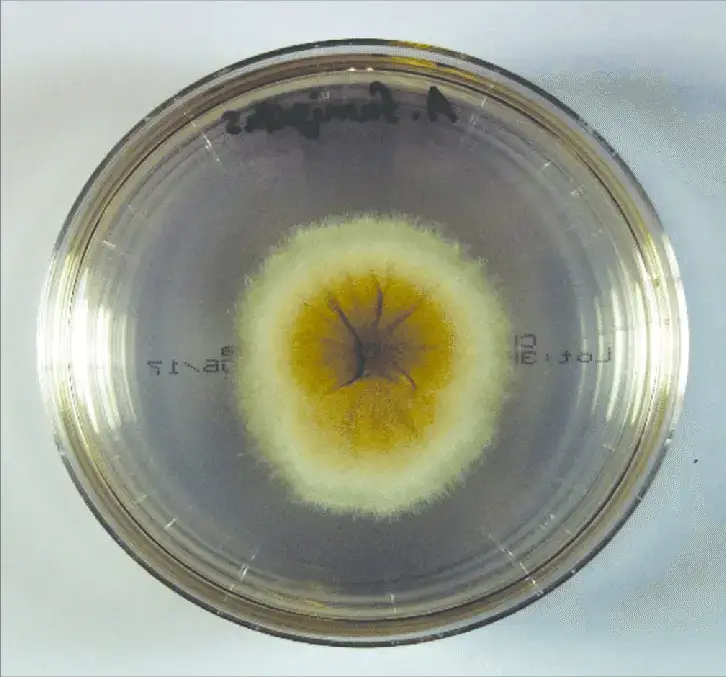
- Potato dextrose agar (PDA): This is another general-purpose medium that is commonly used to grow fungi, including Aspergillus fumigatus. It contains potato infusion, dextrose, and agar, and has a pH of around 5.6.
- Czapek-Dox agar: This medium is specifically designed for the cultivation of filamentous fungi such as Aspergillus spp. It contains sodium nitrate, potassium phosphate, magnesium sulfate, glucose, and agar, and has a pH of around 7.3.
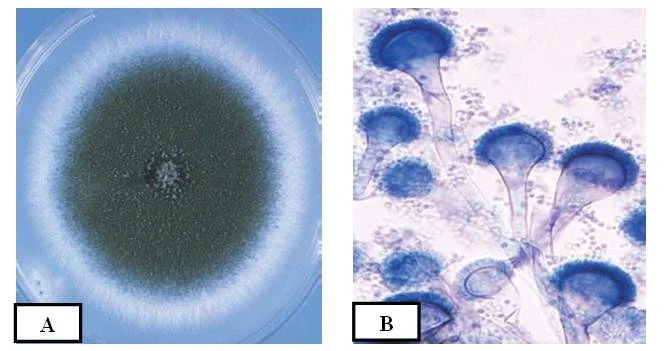
- Aspergillus agar: This medium is formulated specifically for the isolation and identification of Aspergillus spp. It contains yeast extract, peptone, glucose, sodium chloride, and agar, and has a pH of around 5.6.
- Malt extract agar (MEA): This medium is commonly used to grow Aspergillus fumigatus for research purposes. It contains malt extract, peptone, and agar, and has a pH of around 5.6.
These are some of the commonly used culture media for the growth of Aspergillus fumigatus, but there are other specialized media that may also be used depending on the specific research or diagnostic needs.
How to grow Aspergillus fumigatus in laboratory?
To grow Aspergillus fumigatus in the laboratory, the following steps can be followed:
- Prepare the culture medium: Choose an appropriate culture medium, such as Sabouraud agar or Potato dextrose agar, and prepare it according to the manufacturer’s instructions.
- Inoculate the medium: Using sterile technique, inoculate the culture medium with a small amount of Aspergillus fumigatus spores or mycelium. This can be done by using a sterile loop to transfer the spores or mycelium from a previous culture or by scraping spores from a fresh culture onto the medium.
- Incubate the culture: Place the inoculated culture medium in an incubator at the appropriate temperature and humidity for Aspergillus fumigatus growth. The optimal temperature for growth is around 37°C, but the fungus can also grow at lower temperatures, such as 30°C or 25°C.
- Monitor the culture: Check the culture regularly for growth of Aspergillus fumigatus. The fungus typically forms fluffy, cottony colonies that may have a greenish or grayish tinge.
- Harvest the spores: Once the culture has reached maturity, harvest the spores by flooding the surface of the culture with sterile water or saline solution and collecting the spores with a sterile loop or swab. The spores can then be used for further experiments or diagnostic tests.
It is important to maintain proper sterile technique throughout the process to prevent contamination from other microorganisms. Additionally, appropriate safety precautions should be taken when working with Aspergillus fumigatus, as it is a potential pathogen that can cause respiratory infections in susceptible individuals.
Life Cycle of Aspergillus fumigatus

Aspergilli are predominantly saprophytes, growing on decomposing or decaying organic matter. The infectious life cycle of Aspergillus begins with the production of conidia (asexual spores) that are readily dispersed through the air, ensuring its prevalence in both indoor and outdoor environments. Inhalation of these airborne conidia is the primary route of infection in humans, followed by conidial deposition in the bronchioles or alveolar spaces. Conidia not removed by mucociliary clearance encounter epithelial cells or alveolar macrophages, the primary resident phagocytes of the lung, in healthy individuals. Alveolar macrophages are responsible for the phagocytosis and destruction of Aspergillus conidia, as well as the initiation of a proinflammatory response that recruits neutrophils (one type of polymorphonuclear cell [PMN]) to the site of infection. Conidia that elude macrophage destruction and germinate become the target of neutrophils capable of destroying hyphae. The risk of developing IA is predominantly attributable to a dysfunction in these host defenses in conjunction with fungal characteristics that allow A. fumigatus to survive and grow in this pulmonary environment. Although other host responses have been associated with disease resistance, the focus of this review will be on the interactions between fungi and the most essential innate components for fungi’s defense.
Pathogenesis of Aspergillus fumigatus
Pathogenesis of Aspergillus fumigatus involves several steps, including transmission, host colonization, evading macrophage mechanisms, and dissemination. Here is a brief overview of each step:
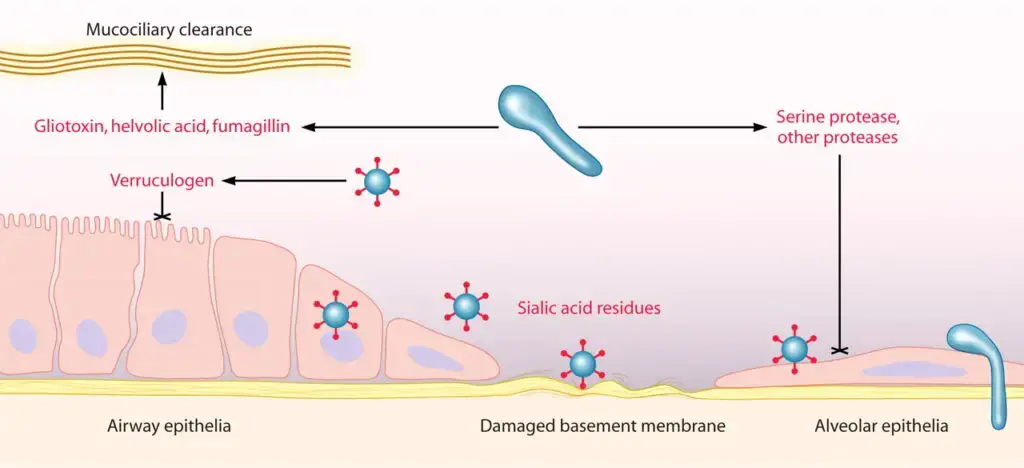
- Transmission: Aspergillus fumigatus is a ubiquitous fungus that is found in soil, water, and decaying plant material. It is transmitted to humans primarily through inhalation of airborne spores, which can be generated from environmental sources or from contaminated medical devices or hospital air conditioning systems.
- Host colonization: After inhalation, Aspergillus fumigatus spores can colonize the respiratory tract and lungs of susceptible hosts, particularly those with compromised immune systems. The fungus can grow and invade the lung tissue, leading to inflammation and tissue damage.
- Evading macrophage mechanisms: Aspergillus fumigatus has evolved several mechanisms to evade the host immune response, particularly macrophage-mediated phagocytosis. The fungus can produce melanin, a pigment that inhibits phagocytosis, and it can also release enzymes and toxins that damage host cells and impair immune function. Reduced alveolar macrophage effector functions in patients at risk for AI contribute to A. fumigatus’ ability to evade macrophage destruction. A. fumigatus only induces an inflammatory response when its conidia germinate. Macrophages can only identify A. fumigatus conidia if beta(1,3)-glucan is present on the conidial surface. Hidden behind an outer layer of the cell wall, this carbohydrate attaches to dectin-1 on the surface of alveolar macrophages, initiating phagocytosis, macrophage activation, and inflammation. The pigment melanin and other enzymes, such as superoxide dismutases, which function as reactive oxygen species (ROS) scavengers, protect conidia from macrophage killing.
- Dissemination: As Aspergillus fumigatus hyphae develop, they have the ability to invade host endothelial cells which are located near the lungs. At first, the hyphae are found on the exterior of the vessel and gradually move through the cells towards the interior of the blood vessel. Upon reaching the blood, fragments may break off and circulate throughout the bloodstream. Once in the blood, these hyphal fragments can attach themselves to the luminal side of other endothelial cells and grow towards the abluminal side. This distinct hyphael growth, either towards or away from the lumen, is facilitated using diverse mechanisms. Hyphael growth into a blood vessel does not trigger the growth of endothelial cell pseudopods, and growth towards the lumen causes less damage to host cell tissue compared to growth leaving the blood vessel. Dissemination of Aspergillus fumigatus is a serious concern, as once the pathogen gains entry to the bloodstream, it is difficult to control its growth throughout the body.
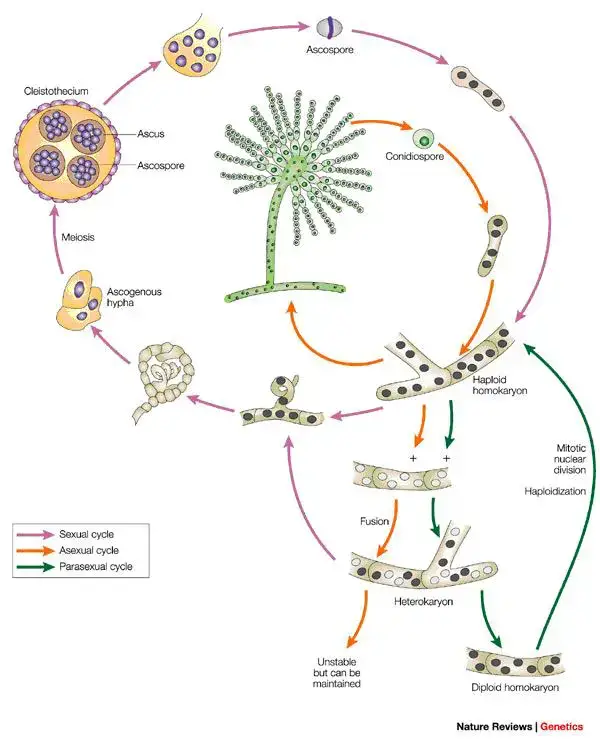
Overall, the pathogenesis of Aspergillus fumigatus involves a complex interplay between the host immune response and fungal virulence factors. The ability of the fungus to colonize and invade host tissues, evade immune mechanisms, and disseminate to other organs is influenced by a variety of host and environmental factors, and is an active area of research.
Clinical manifestation of Aspergillus fumigatus infection
Aspergillus fumigatus can cause a range of clinical manifestations, depending on the location and severity of the infection. Here are some of the common clinical manifestations of Aspergillus fumigatus infection:
- Invasive pulmonary aspergillosis (IPA): This is the most common clinical manifestation of Aspergillus fumigatus infection. IPA typically affects individuals with weakened immune systems, such as those undergoing chemotherapy, organ transplantation, or corticosteroid therapy. The symptoms of IPA include fever, cough, chest pain, shortness of breath, and hemoptysis. IPA can progress rapidly and can be life-threatening if not treated promptly.
- Aspergilloma: Aspergilloma is a fungal ball that forms in pre-existing lung cavities or cysts, particularly in individuals with pre-existing lung disease, such as tuberculosis or emphysema. Aspergilloma may be asymptomatic, but can also cause cough, chest pain, and hemoptysis.
- Allergic bronchopulmonary aspergillosis (ABPA): ABPA is a hypersensitivity reaction to Aspergillus fumigatus, typically seen in individuals with asthma or cystic fibrosis. The symptoms of ABPA include cough, wheezing, and sputum production, and can be accompanied by fever and malaise. Long-term untreated ABPA can lead to lung fibrosis.
- Sinusitis: Aspergillus fumigatus can also cause sinusitis, particularly in individuals with chronic rhinosinusitis or immune system dysfunction. The symptoms of Aspergillus fumigatus sinusitis include nasal congestion, headache, facial pain, and fever.
- Cutaneous aspergillosis: Aspergillus fumigatus can also cause skin infections, particularly in immunocompromised individuals with pre-existing skin lesions or wounds. The symptoms of cutaneous aspergillosis include skin lesions, fever, and systemic symptoms.
Laboratory diagnosis Methods of Aspergillus fumigatus
There are several laboratory diagnosis methods for Aspergillus fumigatus, including:
- Microscopic examination: Microscopic examination of clinical specimens, such as sputum, bronchoalveolar lavage (BAL), or tissue biopsy, can be used to identify Aspergillus fumigatus hyphae. The hyphae are typically septate with acute-angle branching, which is characteristic of Aspergillus spp.
- Culture: Culture of clinical specimens on appropriate media, such as Sabouraud agar or potato dextrose agar, can be used to grow Aspergillus fumigatus. The colonies are typically woolly or cottony in texture, and have a white or grayish color.
- Polymerase chain reaction (PCR): PCR-based assays can be used to amplify Aspergillus fumigatus DNA in clinical specimens, such as BAL or blood. These assays are highly sensitive and specific, and can provide rapid diagnosis of Aspergillus fumigatus infection.
- Serology: Serological assays, such as enzyme-linked immunosorbent assay (ELISA) or immunodiffusion, can detect Aspergillus fumigatus-specific antibodies in the blood. These assays are useful for diagnosing chronic or invasive aspergillosis.
- Imaging studies: Imaging studies, such as chest X-ray or computed tomography (CT) scan, can reveal characteristic findings of Aspergillus fumigatus infection, such as nodules or cavitary lesions in the lungs.
Treatment of Aspergillus fumigatus
The treatment of Aspergillus fumigatus infection depends on the severity of the infection and the patient’s immune status. Some of the treatment options are:
- Antifungal therapy: Antifungal medications, such as azoles, echinocandins, and amphotericin B, are the mainstay of treatment for Aspergillus fumigatus infections. The choice of medication depends on the severity of the infection and the patient’s underlying medical conditions.
- Surgery: Invasive aspergillosis may require surgical intervention, such as removal of infected tissue or drainage of abscesses.
- Immunotherapy: Immunotherapy, such as interferon-gamma or granulocyte colony-stimulating factor (G-CSF), may be used in combination with antifungal therapy in patients with severe or refractory infections.
- Supportive care: Supportive care, such as oxygen therapy or mechanical ventilation, may be necessary in patients with severe respiratory compromise.
- Prevention: In high-risk patients, such as those with neutropenia or undergoing stem cell transplantation, prophylactic antifungal therapy may be used to prevent Aspergillus fumigatus infection.
Prevention and Control of Aspergillus fumigatus
Prevention and control of Aspergillus fumigatus involves several strategies, including:
- Environmental control: Aspergillus fumigatus is ubiquitous in the environment and can be found in soil, compost, and decaying vegetation. Therefore, controlling environmental exposure to Aspergillus fumigatus is important, especially in healthcare settings. This can be achieved by maintaining proper ventilation, avoiding construction or renovation activities in patient care areas, and ensuring that air conditioning and heating systems are clean and functioning properly.
- Infection control measures: Healthcare facilities should implement infection control measures, such as hand hygiene, isolation precautions, and appropriate use of personal protective equipment, to prevent transmission of Aspergillus fumigatus infections between patients and healthcare workers.
- Prophylactic antifungal therapy: In high-risk patients, such as those with neutropenia or undergoing stem cell transplantation, prophylactic antifungal therapy may be used to prevent Aspergillus fumigatus infection.
- Vaccination: Currently, there are no vaccines available for Aspergillus fumigatus. However, research is ongoing to develop vaccines that can protect high-risk individuals from infection.
- Education: Education of patients, healthcare workers, and the general public about the risk factors, signs and symptoms, and prevention of Aspergillus fumigatus infection is important for reducing the incidence of this infection.
Aspergillus fumigatus Images
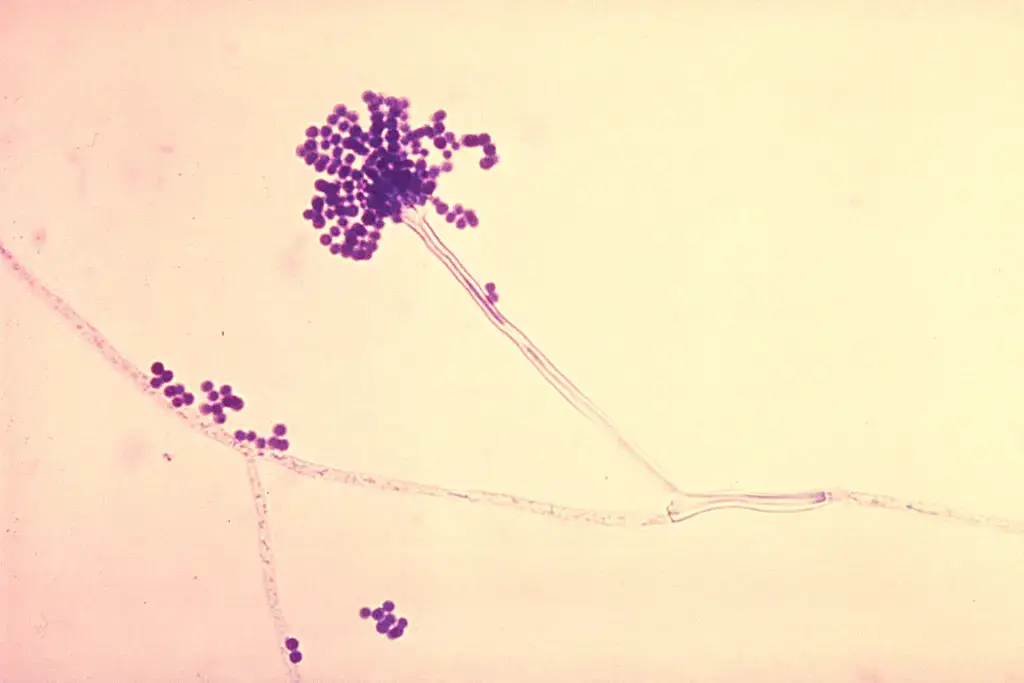
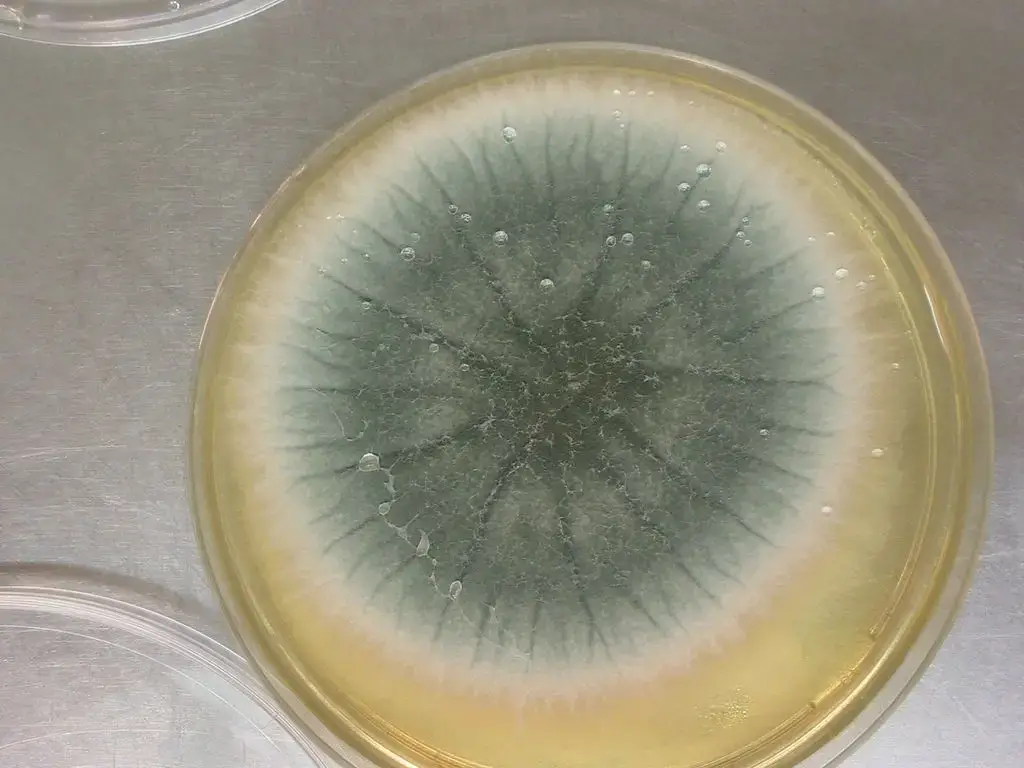
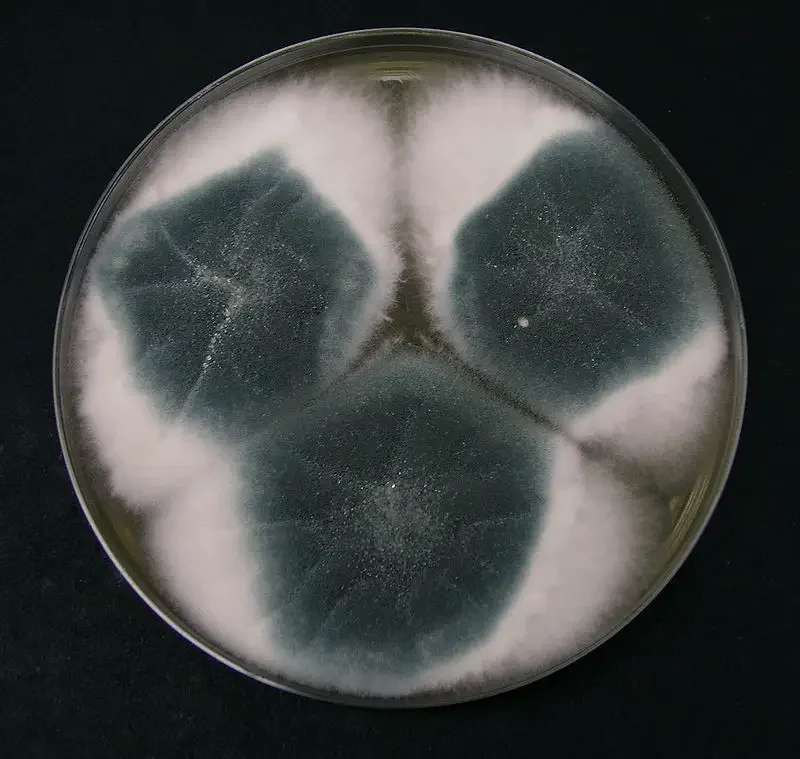
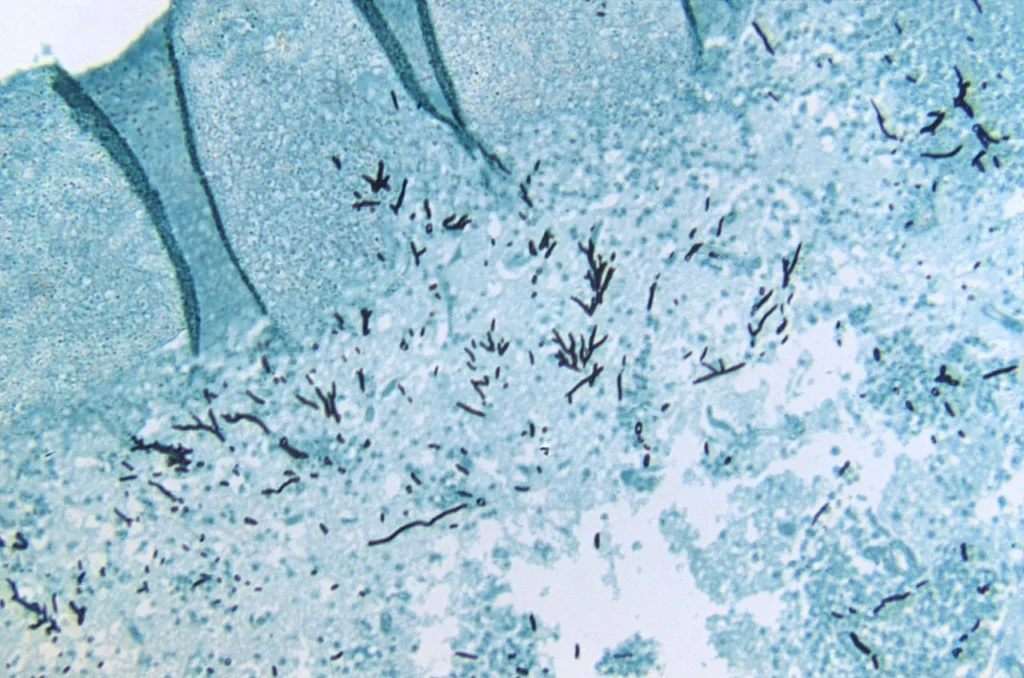

FAQ
What is Aspergillus fumigatus?
Aspergillus fumigatus is a fungus that is commonly found in the environment, especially in soil, compost, and decaying vegetation. It can cause a wide range of infections, especially in immunocompromised individuals.
How does Aspergillus fumigatus cause disease?
Aspergillus fumigatus can cause disease by invading the respiratory tract, blood vessels, and other tissues. It can also produce toxins that can damage cells and tissues.
What are the symptoms of Aspergillus fumigatus infection?
The symptoms of Aspergillus fumigatus infection depend on the site of infection, but can include fever, cough, chest pain, shortness of breath, and fatigue.
Who is at risk of Aspergillus fumigatus infection?
Individuals with weakened immune systems, such as those undergoing chemotherapy or stem cell transplantation, are at increased risk of Aspergillus fumigatus infection. Other risk factors include chronic lung disease and exposure to environmental sources of the fungus.
How is Aspergillus fumigatus infection diagnosed?
Aspergillus fumigatus infection is diagnosed through a combination of clinical signs and symptoms, radiographic findings, and laboratory tests such as culture, serology, and molecular assays.
What is the treatment for Aspergillus fumigatus infection?
The treatment for Aspergillus fumigatus infection involves antifungal medications, surgery, immunotherapy, supportive care, and prevention strategies. The choice of treatment depends on the severity of the infection and the patient’s underlying medical conditions.
Can Aspergillus fumigatus infection be prevented?
Yes, Aspergillus fumigatus infection can be prevented through environmental control, infection control measures, prophylactic antifungal therapy, vaccination (when available), and education.
Is Aspergillus fumigatus infection contagious?
No, Aspergillus fumigatus infection is not contagious and cannot be spread from person to person.
How common is Aspergillus fumigatus infection?
Aspergillus fumigatus infection is relatively uncommon in healthy individuals, but can be a significant problem in immunocompromised patients. It is estimated that up to 10% of patients with hematologic malignancies or stem cell transplantation develop invasive aspergillosis.
What is the prognosis for Aspergillus fumigatus infection?
The prognosis for Aspergillus fumigatus infection depends on the severity of the infection, the patient’s underlying medical conditions, and the timeliness and effectiveness of treatment. In general, the mortality rate for invasive aspergillosis is high, especially in immunocompromised patients.
References
- Latgé JP. Aspergillus fumigatus and aspergillosis. Clin Microbiol Rev. 1999 Apr;12(2):310-50. doi: 10.1128/CMR.12.2.310. PMID: 10194462; PMCID: PMC88920.
- Bandres MV, Modi P, Sharma S. Aspergillus Fumigatus. [Updated 2022 Aug 8]. In: StatPearls [Internet]. Treasure Island (FL): StatPearls Publishing; 2023 Jan-. Available from: https://www.ncbi.nlm.nih.gov/books/NBK482464/
- Latgé, J.-P., & Chamilos, G. (2019). Aspergillus fumigatus and Aspergillosis in 2019. Clinical Microbiology Reviews, 33(1). doi:10.1128/cmr.00140-18
- Latgé, J.-P. (1999). Aspergillus fumigatus and Aspergillosis. Clinical Microbiology Reviews, 12(2), 310–350. doi:10.1128/cmr.12.2.310
- https://microbewiki.kenyon.edu/index.php/Aspergillus_fumigatus_and_Aspergillosis
